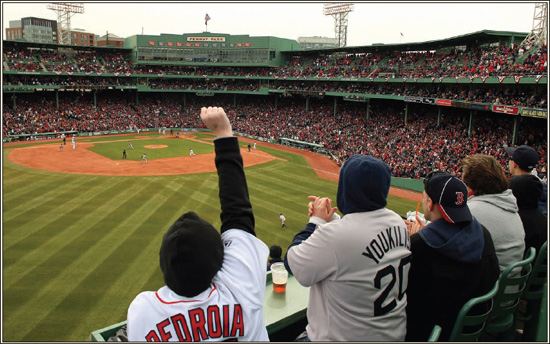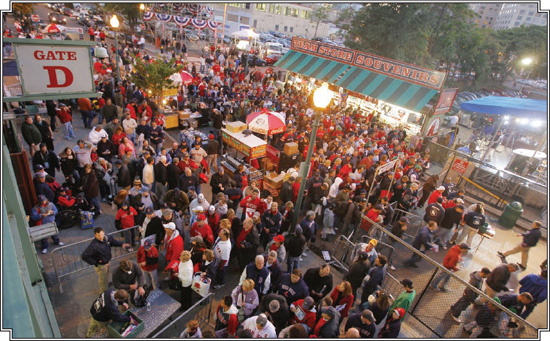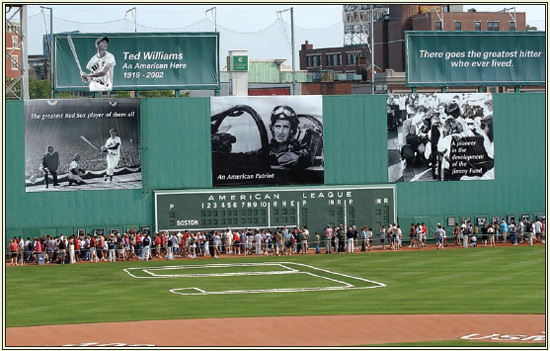Fenway Park (51 page)
Authors: John Powers
A Red Sox groundskeeper scaled the ladder to the top of the Green Monster to retrieve baseballs hit into the netting during batting practice.
At season’s end, Boston was 13½ games behind New York and the collapse set the stage for a massive transformation before the 2002 season that featured new ownership, a new GM, and a new manager. The biggest change came in December when a group headed by Marlins owner John Henry bought the franchise from the Yawkey Trust for $700 million, more than twice the previous record paid for a Major League Baseball team.
It was the first time since 1933 that the club had been sold.
Henry, who gave up his Florida Marlins stake, took over as the club’s principal owner, while former San Diego owner Tom Werner became chairman, and former San Diego and Baltimore chief executive Larry Lucchino assumed the role of president.
When the new group took over in March, they immediately made changes, replacing General Manager Dan Duquette with assistant Mike Port on an interim basis and hiring Grady Little, a former bench coach, to succeed Kerrigan, whose tenure lasted only 43 games.
There were changes to Fenway, too, as the owners endeavored to show the faithful that they were committed to restoration instead of relocation. “When I think of Paris I think of the Eiffel Tower,” Henry mused. “When I think of Boston, I think of Fenway.”
Before Opening Day, the ballpark was painted, the clubhouses freshened, and 10 new concession stands and 400 new seats were added. “Fans want to be at the game,” said Henry, who ensconced himself in a front-row box for the unveiling. “So we’ll put them on the field, we’ll put them on the rooftops, we’ll even put them on the bench.”
The fans soon got a close-up of the first Fenway no-hitter since Dave Morehead’s in 1965 and it came from an unlikely source—Derek Lowe, who’d been booed mercilessly during his 5-10 campaign the previous year. “It’s surreal,” marveled Lowe, whose teammates presented him the ball on a silver platter after he’d allowed Tampa Bay only one base runner during his 10-0 masterpiece on April 27.
While Lowe went on to start the All-Star Game and have a career year (21-8), his teammates faded after a 40-17 start that helped them stay in first place until late June; they finished more than 10 games astern.
Sport’s most storied rivalry heated up during the off-season when Lucchino referred to the Yankees as the “Evil Empire“ and New York owner George Steinbrenner called the Sox president the game’s “foremost chameleon of all time.” The clubs fought each other to a near-standstill in 2003, with New York winning the season series, 10-9. “They know we are here,” Little proclaimed in late July. “And they know that we are not going away.”
SWEET SEATS
They have been voted the best seats in baseball by ESPN SportsTravel and
USA Today
. And even Fenway purists would have to admit that when the Red Sox added seats atop the left-field wall, they did it right.
When his ownership group took over the team in 2002, John Henry broached the idea of putting seats atop the 37-foot-tall Green Monster, which has been called the most famous wall this side of China. It wasn’t the first renovation project Henry & Co. undertook, but, initially, it was the most controversial.
“Certainly there were raised eyebrows,” recalled Charles Steinberg, former Red Sox executive vice president for public affairs. But by the time the project was finished, it became the most popular of the many ballpark upgrades. Henry credits Janet Marie Smith, the Red Sox senior vice president of planning and development, with the design of 269 stools with bar rails. The section has three rows, plus a fourth of standing-room-only and concession stands. The Red Sox resisted the urge to cram in as many seats as possible.
The challenge, said Smith, was “how to put seats up there without overpowering the Green Monster. We wanted to make the seats special even after the novelty wore off.”
“They should’ve done it years ago,” Marty Feeney, of Quincy, Massachusetts, told the Denver Post when he attended the 2007 World Series. “Now you get the real feel of a home-run shot. The camera’s on you. You get your one minute of fame.”
During a game in 2008, one fan atop the Monster was swamped with text messages from friends within seconds after he narrowly missed catching a home-run ball.
Smith was with the Red Sox for nearly eight years (she left in 2009 to help renovate the Rose Bowl), during which time the team spent roughly $150 million on improvements to the park, increasing Fenway’s capacity by 5,000, while waterproofing its leaky stands and reinforcing its foundations to last another 40 years.
Another of the most popular changes is just outside the walls of the park: the Yawkey Way concourse, which debuted in 2002. The street named for longtime owner Tom Yawkey is closed to traffic and non-ticket holders on game days, creating a sort of street carnival with entertainment, food carts, vendors, and often a chance to visit with and get an autograph from a former Sox player.
RECENT CHANGES MADE TO FENWAY:
| 2002: | Dugout seats and Yawkey Way concourse. |
| 2003: | Green Monster seats and right-field concourse. |
| 2004: | Right-field roof seats. |
| 2005: | Third-base concourse and Game On! Sports Bar. |
| 2006: | EMC Club and State Street Pavilion. |
| 2007: | Jordan’s Third-Base Deck. |
| 2008: | State Street Pavilion expansion, Coca-Cola Corner, Bleacher Bar under center-field bleachers. |
| 2009: | Right-field roof renovations, repair of original 1912 seating bowl. |

“When I was there, I always realized there was something bigger than us as players: these people that had bled, cried tears, and cheered over the years. Winning a World Series in Boston is more than an individual player winning a World Series—it was winning a World Series for these people.”
—Nomar Garciaparra, March 2010
The Sox had become relentless buckaroos who rode into the late summer with a sense of urgency, sporting red T-shirts that declared “THE TIME IS NOW . . . SO COWBOY UP.” Yet Boston needed a near-miracle to earn a postseason date with the Yankees after losing the first two games of their best-of-five divisional series at Oakland. “I know it can be done,” said Varitek, who had played on the 1999 club that had come back to beat the Indians after spotting them a 2-0 advantage in the playoffs. “Just let us get home and see what happens.”
The odds, though, were daunting, especially given that the Sox had lost 10 straight playoff games to the Athletics. “[Our fans] may be jumping off bridges,” conceded Garciaparra, “but I guarantee they’ll get out of the water and they’ll be out there supporting us on Saturday.”
It was almost Sunday morning by the time the club began its great escape with Trot Nixon’s long, looping pinch-hit homer into the center-field seats for a walk-off victory in the 11
th
inning. “There was a little gust of wind from the good Lord,” said Nixon, after his homer sealed the 3-1 triumph, “and it ended up going out of the ballpark.”
There was an earthly intervention on Sunday afternoon from David Ortiz, who cranked the winning double off the Oakland bullpen in the eighth. “I’ve never cried at a baseball game before but I couldn’t help it,” said Henry after Ortiz, who’d been 0 for 16 in the series, knocked in Garciaparra and Ramirez for a most unlikely 5-4 decision. “It was an unforgettable moment.”

A street-fair atmosphere took root on Yawkey Way outside Fenway Park beginning in 2002, but it’s for ticket-holders only. No ticket? The Cask ‘n Flagon still accepts all comers.
SO LONG, TEDDY BALLGAME
When Ted Williams died at 83 on July 5, 2002, there was no wake and no funeral. Only the makings of a circus, with his three children battling over what exactly his last intentions were, and son John Henry Williams insisting that his father had signed an agreement to be cryonically frozen in Arizona.
Though the legal battle over Williams’s remains would play out for months, the Red Sox held a ceremony in his honor on July 22 at Fenway Park, where lifelong friends and former teammates found kinship and a measure of closure for the passing of “Teddy Ballgame.”
“The tribute was to him and his life, what he did on and off the field,” said former Sox shortstop Rico Petrocelli. “And that’s the way it should have been. I think we needed this, we being Boston and the former players, needed this closure.”
Jerry Coleman, a former Yankee rival and fellow fighter pilot, met Williams at the 1950 All-Star Game. He said he immediately admired Williams. “He went to the wall to make a catch and crashed into it. He broke his arm,” said Coleman. A few innings later, Williams came to the plate and singled. “I was thinking, ‘Geez, this guy hits better with a broken arm than most guys do with two arms.’”
Said Dan Shaughnessy: “Teddy Ballgame was our own Babe Ruth, an oversized figure who forged his way into every New England household. . . . Forget cryonics. The Kid stays alive through folklore, the telling of tall tales. He’s a baseball Bunyan.”
In a sad footnote to the Williams ceremony, long-time Sox announcer Ned Martin died of an apparent heart attack at the Raleigh airport after participating in the tribute at Fenway. Martin, who delighted New England with his erudition and gentle wit, described the Sox action on radio and television between 1961 and 1992.
Martin served in the Marines in World War II and saw action in Iwo Jima. He worked with Ken Coleman on Sox TV broadcasts from 1966-72. He famously cried, “There’s pandemonium on the field” when Petrocelli caught the pop-up to end the final game of the 1967 regular season, as the Sox won their first pennant in 21 years.
